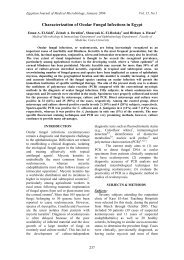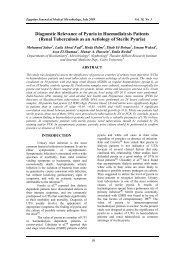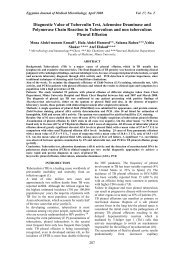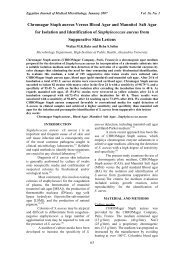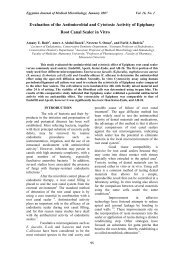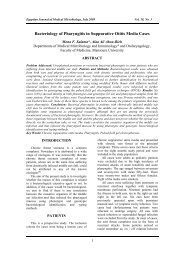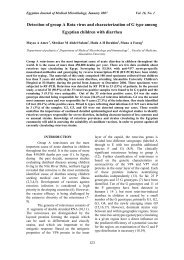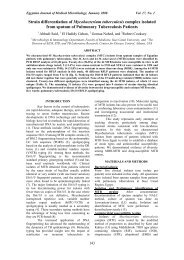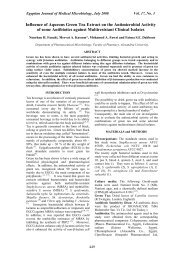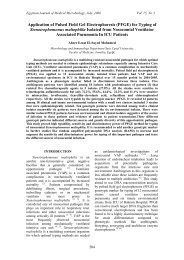Antifungal Susceptibility Patterns of Dermatophytes Clinical Isolates ...
Antifungal Susceptibility Patterns of Dermatophytes Clinical Isolates ...
Antifungal Susceptibility Patterns of Dermatophytes Clinical Isolates ...
You also want an ePaper? Increase the reach of your titles
YUMPU automatically turns print PDFs into web optimized ePapers that Google loves.
Egyptian Journal <strong>of</strong> Medical Microbiology, January 2010 Vol. 19, No. 1<br />
<strong>Antifungal</strong> <strong>Susceptibility</strong> <strong>Patterns</strong> <strong>of</strong> <strong>Dermatophytes</strong> <strong>Clinical</strong><br />
<strong>Isolates</strong> from Dermatophytosis Patients before and After Therapy<br />
Howyda M. Ebrahim 1 , Ahmed M. asaad 2 and Ahmed Amer 2<br />
Dermatology&Venereology 1 and Microbiology&Immunology 2 Departments, Faculty <strong>of</strong><br />
Medicine, Zagazig University<br />
ABSTRACT<br />
The determination <strong>of</strong> fungus in vitro antifungal susceptibility has been reported to be important for the<br />
ability to eradicate pathogenic dermatophytes. This work aims to assess the in vitro activity <strong>of</strong><br />
fluconazole, ketoconazole and itraconazole against dermatophytes from dermatophytosis patients before<br />
and after oral antifungal therapy with itraconazole. The study was conducted on 80 patients with<br />
dermatomycosis attending the Deramtology Outpatient Clinic <strong>of</strong> Zagazig University Hospitals. The<br />
patients were clinically diagnosed and mycologically confirmed as having tinea capitis (42), tinea<br />
corporis (18), tinea pedis (12), tinea ungium (5) and tinea cruris (3). All patients received a course <strong>of</strong><br />
pulse itraconazole therapy. The clinical specimens were collected from all patients before and after 3<br />
months <strong>of</strong> itraconazole oral therapy. Identification <strong>of</strong> dermatophytes to the species level was performed<br />
by colony morphology, microscopy and biochemical and physiological tests. All dermatophytes isolates<br />
were subjected to antifungal susceptibility testing by E-test method. In this work, the most frequently<br />
isolated species was T. rubrum, comprising 25 (31.25%) isolates, followed by T. mentagrophytes (21<br />
isolates, 26.25%), T. violacium (17 isolates, 21.25%), M. canis (7 isolates, 8.75%), T. schoenlinii (6<br />
isolates, 7.5%) and M. audouinii (4 isolates, 5%). The most active agent against all dermatophytes<br />
species was itraconazole with an MIC range <strong>of</strong> 0.094 – 12 µg/ml., MIC50 values <strong>of</strong> 0.125-0.5 µg/ml and<br />
MIC90 values <strong>of</strong> 0.25-8 µg/ml., followed by ketoconazole (MIC range <strong>of</strong> 0.0.64-24 µg/ml., MIC50 values<br />
<strong>of</strong> 0.38-1 µg/ml. and MIC90 values <strong>of</strong> 2-8 µg/ml). The least active agent was fluconazole (MIC50 <strong>of</strong> 64-<br />
≥256 µg/ml. and MIC90 <strong>of</strong> 128-≥256 µg/ml). MIC values higher than MIC90 were observed for the azole<br />
drugs when testing isolates obtained post-treatment from four tinea unguium patients. In conclusion, our<br />
data showed that itraconazole was the most active azole against all dermatophytes isolates. Furthermore,<br />
the increase in MIC values for azole drugs found for some <strong>of</strong> our isolates after therapy might raise the<br />
possibility <strong>of</strong> increased antifungal resistance. Further studies on larger samples <strong>of</strong> dermatophytes are<br />
recommended to correlate the MIC values with the clinical outcome for each isolate-drug combination to<br />
allow clinician adapting different therapeutic options. In addition, these studies could be beneficial for<br />
investigation <strong>of</strong> development <strong>of</strong> in vitro resistance in dermatophytes species, and for management <strong>of</strong> cases<br />
clinically unresponsive to treatment.<br />
INTRODUCTION<br />
<strong>Dermatophytes</strong> are a group <strong>of</strong> closely<br />
related fungal species that have the capacity to<br />
invade keratinized tissue <strong>of</strong> human and other<br />
vertebrates and produce dermatophytosis.<br />
Infections caused by these fungi are among the<br />
most prevalent cutaneous infections globally<br />
and the recent increase in the number <strong>of</strong> patients<br />
with immunocompromised states, such as<br />
AIDS, diabetes mellitus, cancer and organ<br />
transplantation has given these infections more<br />
prominence (1-2)<br />
The treatment <strong>of</strong> dermatophytosis is based<br />
on the use <strong>of</strong> topical and systemic antifungal<br />
agents. While topical application <strong>of</strong> an<br />
antifungal is usually sufficient to eradicate the<br />
organism and to cure the majority <strong>of</strong> these<br />
infections, the most severe and chronic<br />
dermatophytosis, which includes some tinea<br />
unguium, scalp ringworm and skin lesions with<br />
41<br />
folliculitis, <strong>of</strong>ten requires the administration <strong>of</strong><br />
systemic treatment (3)<br />
Although an increasing number <strong>of</strong><br />
antimycotics has become available for the<br />
treatment <strong>of</strong> dermatophytosis, there are reports<br />
suggesting recalcitrance to therapy or possibly<br />
even resistance <strong>of</strong> dermatophytes to<br />
antimicrobial agents (4) . In order to predict the<br />
ability <strong>of</strong> a given antimycotic agent to eradicate<br />
dermatophytes and help managing patients,<br />
determination <strong>of</strong> the in vitro antifungal<br />
susceptibility <strong>of</strong> dermatophytes would be<br />
helpful in understanding a failed or successful<br />
treatment (5) . However, studies on the correlation<br />
<strong>of</strong> minimum inhibitory concentration (MIC)<br />
values to the clinical outcome are rare.<br />
Moreover, dermatophytes have not been<br />
included in the in vitro method proposed by the<br />
<strong>Clinical</strong> Laboratory Standards Institute (CLSI)<br />
for testing filamentous fungi (6) .
Egyptian Journal <strong>of</strong> Medical Microbiology, January 2010 Vol. 19, No. 1<br />
This work aims to assess the in vitro<br />
activity <strong>of</strong> fluconazole, ketoconazole and<br />
itraconazole against dermatophytes from<br />
dermatophytosis patients before and after oral<br />
antifungal therapy with itraconazole.<br />
PATIENTS, MATERIALS &<br />
METHODS<br />
This study was conducted on 80 patients<br />
with dermatomycosis <strong>of</strong> skin, hair and nail<br />
attending the Deramtology Outpatient Clinic <strong>of</strong><br />
Zagazig University Hospitals. Their age ranged<br />
from 12 to 56 years (21.7±14.5 SD). They were<br />
48 females and 32 males. The patients were<br />
clinically diagnosed and mycologically<br />
confirmed as having tinea capitis (42 case),<br />
tinea corporis (18 cases), tinea pedis (12 cases),<br />
tinea ungium (5 cases) and tinea cruris (3 cases).<br />
All patients received a course <strong>of</strong> pulse<br />
itraconazole therapy. The dosage <strong>of</strong> itraconazole<br />
was approximately 5 mg/Kg daily to twice-daily<br />
for one week <strong>of</strong> each <strong>of</strong> the 3-months course<br />
(from 2 weeks to 3 months) (7) .<br />
<strong>Clinical</strong> specimens<br />
The clinical specimens including cutaneous<br />
skin scales, hair and nail scrapings or eclipses<br />
were collected from all patients at two points:<br />
before and after 3 months <strong>of</strong> antifungal oral<br />
therapy with itraconazole. The specimens were<br />
subjected to:<br />
‐ Direct microscopic examination using 10%<br />
KOH<br />
‐ Culture on Sabouraud’s dextrose agar with<br />
chloramphenicol and cyclohexamide<br />
(Oxoid, UK). The cultures were incubated<br />
at 28ºC and examined daily for 30 days.<br />
‐ Identification <strong>of</strong> dermatophytes to the<br />
species level was performed by colony<br />
morphology, microscopy and physiological<br />
and biochemical tests including urease and<br />
pigment production tests (8)<br />
<strong>Antifungal</strong> susceptibility testing<br />
All dermatophytes isolates were subjected<br />
to antifungal susceptibility testing by E-test<br />
method according to the manufacturer’s<br />
instructions using E-test strips (AB Biodisk,<br />
Slona, Sweden) for fluconazole, ketoconazole<br />
and itraconazole.<br />
For each isolate, a suspension <strong>of</strong> mycelia<br />
from a 7-day culture was prepared in saline to a<br />
concentration <strong>of</strong> 10 6 cells/ml. The suspensions<br />
were streaked into Sabouraud’s glucose agar<br />
with the aid <strong>of</strong> moistened swabs. A strip <strong>of</strong> E-<br />
test was then carefully placed on the center <strong>of</strong><br />
each plate and incubated at 28ºC for reading at<br />
96 hours. The MIC values were the drug<br />
concentrations at which the border <strong>of</strong> the<br />
elliptical inhibition zone intersected the scale on<br />
the antifungal strip. The MIC50 values were the<br />
MIC values which inhibited 50% <strong>of</strong> all isolates<br />
while MIC90 inhibited 90% <strong>of</strong> all isolates. Two<br />
quality control strains were included: Candida<br />
parapsilosis (ATCC 22019) and Trichophyton<br />
rubrum (ATCC 40051) (9) .<br />
RESULTS<br />
In this work a total <strong>of</strong> 80 dermatophytes<br />
strains were isolated from all patients. The most<br />
frequently isolated species was T. rubrum,<br />
comprising 25 (31.25%) isolates, followed by T.<br />
mentagrophytes (21 isolates, 26.25%), T.<br />
violacium (17 isolates, 21.25%), M. canis (7<br />
isolates, 8.75%), T. schoenlinii (6 isolates,<br />
7.5%) and M. audouinii (4 isolates, 5%) as<br />
presented in table (1).<br />
Table (1): The number and percentages <strong>of</strong> dermatophytes species according to the type <strong>of</strong> tinea<br />
Type <strong>of</strong> tinea<br />
<strong>Dermatophytes</strong> species No. (%)<br />
(No.) T. rubrum T. mentagrophytes T. violaceum T. schoenlinii M. canis M. audouinii<br />
Tinea capitis (42) 0 (0) 15 (35.7) 12 (28.6) 6 (14.3) 5 (11.9) 4 (9.5)<br />
Tinea corporis (18) 7 (38.7) 5 (27.8) 4 (22.2) 0 (0) 2 (11.1) 0 (0)<br />
Tinea pedis (12) 10 (83.4) 1 (8.3) 1 (8.3) 0 (0) 0 (0) 0 (0)<br />
Tinea ungium (5) 5 (100) 0 (0) 0 (0) 0 (0) 0 (0) 0 (0)<br />
Tinea cruris (3) 3 (100) 0 (0) 0 (0) 0 (0) 0 (0) 0 (0)<br />
Total (80) 25 (31.25) 21 (26.25) 17 (21.25) 6 (7.5) 7 (8.75) 4 (5)<br />
The MIC values <strong>of</strong> fluconazole,<br />
ketoconazole and itraconazole against the 80<br />
dermatophytes clinical isolates are summarized<br />
in table (2). The most active agent against all<br />
dermatophytes species was itraconazole with an<br />
MIC range <strong>of</strong> 0.094-12 µg/ml., MIC50 values <strong>of</strong><br />
0.125-0.5 µg/ml and MIC90 values <strong>of</strong> 0.25-8<br />
µg/ml., followed by ketoconazole with MIC<br />
range <strong>of</strong> 0.064-24 µg/ml., MIC50 values <strong>of</strong><br />
0.38-1 µg/ml. and MIC90 values <strong>of</strong> 2-8 µg/ml.<br />
The least active agent was fluconazole with<br />
MIC50 <strong>of</strong> 64-≥256 µg/ml. and MIC90 <strong>of</strong> 128-<br />
≥256 µg/ml.<br />
42
Egyptian Journal <strong>of</strong> Medical Microbiology, January 2010 Vol. 19, No. 1<br />
Table (2): The MICs <strong>of</strong> the three antifungals against 80 dermatophytes clinical isolates.<br />
<strong>Dermatophytes</strong><br />
<strong>Antifungal</strong> agents (µg/ml.)<br />
species<br />
Fluconazole Ketokonazole Itraconazole<br />
MIC range MIC50 MIC90 MIC range MIC50 MIC90 MIC range MIC50 MIC90<br />
T. rubrum 128 - ≥256 128 256 0.064 – 24 0.38 6 0.094 – 8 0.25 2<br />
T. mentagrophytes 128 - ≥256 ≥256 ≥256 0.064 – 12 0.5 8 0.094 – 12 0.5 8<br />
T. violaceum 64 – 256 64 128 0.125 – 4 1 2 0.094 – 2 0.125 0.25<br />
T. schoenlinii 32 – 128 N.C. N.C. 0.125 – 2 N.C. N.C. 0.094 – 2 N.C. N.C.<br />
M. canis 128 - ≥256 N.C. N.C. 0.064 – 2 N.C. N.C. 0.094 – 4 N.C. N.C.<br />
M. audouinii 64 – 256 N.C. N.C. 0.25 – 2 N.C. N.C. 0.094 – 2 N.C. N.C.<br />
N.C.: Values not calculated for species with less than 10 isolates.<br />
After 3-month <strong>of</strong> antifungal oral therapy, 12<br />
(15%) <strong>of</strong> 80 patients were not clinically cured,<br />
including 7 tinea pedis and 5 tinea ungium<br />
patients and mycological culture showed T.<br />
rubrum isolates. Table (3) shows the antifungal<br />
susceptibility data for these isolates from<br />
patients before and after therapy. Eight isolates<br />
showed the same or lower MIC values for the<br />
second isolates obtained from patients after<br />
therapy. Whereas, MIC values higher than<br />
MIC90 were observed for the azole drugs when<br />
testing isolates obtained post-treatment from<br />
four tinea unguium patients. MIC values for<br />
ketoconazole and itraconazole for the second<br />
isolates were two to four times higher than the<br />
MIC <strong>of</strong> these drugs for the first isolate from two<br />
patients (ketoconazole MIC90 <strong>of</strong> 12 µg/ml<br />
versus 6 µg/ml and itaconazole MIC90 <strong>of</strong> 8<br />
µg/ml versus 2 µg/ml) and twice as high as the<br />
fluconazole MIC90 for the second isolates from<br />
two patients (MIC90 <strong>of</strong> ≥256 µg/ml versus 128<br />
µg/ml).<br />
Table (3): <strong>Antifungal</strong> susceptibility data for 12 T. rubrum clinical isolates from patients before and after<br />
therapy.<br />
Type <strong>of</strong> tinea<br />
Tinea ungium<br />
Tinea pedis<br />
Tinea pedis<br />
Tinea pedis<br />
Tinea ungium<br />
Tinea ungium<br />
Tinea ungium<br />
Tinea pedis<br />
Tinea ungium<br />
Tinea pedis<br />
Tinea pedis<br />
Tinea pedis<br />
Isolate No<br />
First<br />
Second<br />
First<br />
Second<br />
First<br />
Second<br />
First<br />
Second<br />
First<br />
Second<br />
First<br />
Second<br />
First<br />
Second<br />
First<br />
Second<br />
First<br />
Second<br />
First<br />
Second<br />
First<br />
Second<br />
First<br />
Second<br />
MIC data (µg/ml)<br />
Fluconazole Ketoconazole Itraconazole<br />
256<br />
6<br />
2<br />
128<br />
12<br />
8<br />
256<br />
4<br />
2<br />
256<br />
4<br />
1<br />
256<br />
12<br />
2<br />
256<br />
4<br />
2<br />
>256<br />
6<br />
2<br />
256<br />
6<br />
0.75<br />
256<br />
6<br />
2<br />
128<br />
12<br />
8<br />
128<br />
6<br />
4<br />
256<br />
4<br />
2<br />
128<br />
6<br />
2<br />
>256<br />
6<br />
1<br />
256<br />
6<br />
2<br />
256<br />
4<br />
0.5<br />
>256<br />
24<br />
2<br />
>256<br />
8<br />
1<br />
256<br />
6<br />
2<br />
128<br />
2<br />
2<br />
256<br />
6<br />
2<br />
128<br />
2<br />
1<br />
256<br />
6<br />
2<br />
128<br />
4<br />
2<br />
43
Egyptian Journal <strong>of</strong> Medical Microbiology, January 2010 Vol. 19, No. 1<br />
DISCUSSION<br />
The distribution <strong>of</strong> the dermatophytosis and<br />
their etiological agents has unequal frequencies,<br />
with variations <strong>of</strong> their prevalence according to<br />
the countries and even the regions <strong>of</strong> the same<br />
country. In this study, T. rubrum was the most<br />
frequently isolated organism (31.25%),<br />
followed by T. mentagrophytes (26.25%) and T.<br />
violaceum (21.25%). These results are in<br />
agreement with many other local (10) and<br />
international studies (1) . However, T. violaceum<br />
in Libya, E. floccosum in Iraq and M. canis in<br />
Italy are the most common cause <strong>of</strong><br />
dermatophytosis (11-13) .<br />
The determination <strong>of</strong> fungus in vitro<br />
antifungal susceptibility has been reported to be<br />
important for the ability to eradicate pathogenic<br />
dermatophytes (5) . In this study, itraconazole had<br />
the highest antifungal activity for all<br />
dermatophytes species with the lowest MIC<br />
ranges among the tested azole drugs, including<br />
MIC50 (0.125–0.5 µg/ml) and MIC90 (0.25–8<br />
µg/ml). Similar results have been verified by<br />
other researchers (14-16) . These data can help to<br />
explain the promising results obtained for the<br />
treatment <strong>of</strong> dermatophytosis with this<br />
antifungal agent (17) . The highest MIC values in<br />
this study were for fluconazole (MIC50: 64-256<br />
µg/ml and MIC90: 128-≥256 µg/ml).<br />
Fernandez-Torres et al (14) studying trichophyton<br />
rubrum and trichophyton mentagrophytes<br />
reported MIC values for fluconazole <strong>of</strong> ≥256<br />
µg/ml. The same results were mentioned by<br />
Barros et al (15) .<br />
One <strong>of</strong> the most striking findings <strong>of</strong> our<br />
study was the influence <strong>of</strong> E-test on MICs<br />
compared to values in other studies utilizing<br />
either the broth macro or microdilution<br />
methods (17-19) . A prominent increase in MIC<br />
values with wide MIC ranges was observed in<br />
this work. Mendez et al (19) compared two agarbased<br />
methods, E-test and the disk diffusion<br />
method with the CLSI reference broth<br />
microdilution method for susceptibility testing<br />
<strong>of</strong> 46 dermatophytes strains. These investigators<br />
found that the level <strong>of</strong> agreement between the<br />
E-test and broth microdilution method was<br />
45.6% for fluconazole and 19.5% for<br />
itraconazole. On the other hand, Ferrnandez-<br />
Torres et al (14) found that the agreement between<br />
the E-test and microdilution method was 80%,<br />
77% and 27% for itraconazole, ketoconazole<br />
and fluconazole respectively. It is difficult to<br />
compare results due to variability in critical<br />
technical factors in different studies, including<br />
inoculums size, type <strong>of</strong> media, incubation<br />
44<br />
temperature and time <strong>of</strong> reading, which may<br />
explain the different results in antifungal<br />
susceptibility testing obtained by various<br />
investigators and laboratories (14-16,18&19) .<br />
Therefore, validation <strong>of</strong> the clinical significance<br />
<strong>of</strong> these observations demands determination <strong>of</strong><br />
MIC breakpoints for dermatophytes and in<br />
vitro-in vivo correlation studies.<br />
It is interesting to mention that MIC values<br />
higher than MIC90 were observed for the azole<br />
drugs when testing isolates obtained posttreatment<br />
from four tinea unguium patients in<br />
this work. In accordance, Santos et al (20) found<br />
that the MIC values <strong>of</strong> ketoconazole and<br />
itraconazole for the second isolate from two<br />
onychomycosis patients were four times higher<br />
than the MIC90 <strong>of</strong> these drugs for the first<br />
isolate and the sequential isolates from each<br />
patient exhibited the same genotype<br />
representing a single T. rubrum strain. Whereas,<br />
in other two patients, four times higher MIC<br />
values <strong>of</strong> itraconazole and miconazole for the<br />
second isolates were recorded and the sequential<br />
isolates from each patient were genetically<br />
unrelated representing two different T. rubrum<br />
strains. Moreover, in a study <strong>of</strong> Gupta and<br />
Kohli (21) , which involved MIC determination for<br />
antifungal agents against sequential<br />
dermatophytes isolates obtained from patients<br />
who fail antifungal oral therapy, an increase in<br />
MIC values, especially for ketoconazole, when<br />
testing isolates post-treatment was observed.<br />
These researchers proposed the hypothesis that<br />
there are possibilities <strong>of</strong> increased resistance<br />
developing in the dermatophyte causative agent<br />
and <strong>of</strong> strain selection during the treatment.<br />
From these data, the higher MIC values <strong>of</strong><br />
tested azoles for the second isolates obtained<br />
post-treatment in this work might be related to<br />
emergence <strong>of</strong> genetically different strain<br />
because <strong>of</strong> strain selection during the treatment<br />
or a possibility <strong>of</strong> increased resistance<br />
developing in the same pathogenic strain.<br />
In conclusion, our data showed that<br />
itraconazole was the most active azole against<br />
all dermatophytes isolates, followed by<br />
ketoconazole and fluconazole. Furthermore, the<br />
increase in MIC values for azole drugs found<br />
for some <strong>of</strong> our isolates after therapy might<br />
raise the possibility <strong>of</strong> increased antifungal<br />
resistance. Further studies on larger samples <strong>of</strong><br />
dermatophytes are recommended to correlate<br />
the MIC values with the clinical outcome for<br />
each isolate-drug combination to allow clinician<br />
adapting different therapeutic options with a<br />
high probability <strong>of</strong> successful results. In<br />
addition, these studies could be beneficial for
Egyptian Journal <strong>of</strong> Medical Microbiology, January 2010 Vol. 19, No. 1<br />
investigation <strong>of</strong> development <strong>of</strong> in vitro<br />
resistance in dermatophytes species, and for<br />
management <strong>of</strong> cases clinically unresponsive to<br />
treatment.<br />
REFERENCES<br />
1. Ozkutuk A, Ergon C and Yulug N.<br />
(2007): Species distribution and antifungal<br />
susceptibilities <strong>of</strong> dermatophytes during a<br />
one year period at a university hospital in<br />
Turkey. Mycoses; 50: 125-129.<br />
2. Porro AM, Yosioka CN, Kaminiski SK,<br />
de Palmeira A, Fishman O and Alchorne<br />
M. (1997): Dessiminated dermatophytosis<br />
caused by microsporum gypseum in two<br />
patients with the acquired<br />
immunodeficiency<br />
syndrome.<br />
Mycopathologia; 137: 9-12.<br />
3. Del Palcio A, Garau M, Gonzalez-<br />
Escalada A and Calvo MT. (2000):<br />
Trends in the treatment <strong>of</strong> dermatophytosis.<br />
In: Kushwaha RKS, Guarro J, editors.<br />
Biology <strong>of</strong> dermatophytes and other<br />
keratinophylic fungi. Bilbao, Spain: Revista<br />
Iberoamericana de mycologia; P: 148-158<br />
4. Gupta AK and Kohli Y (2003): In vitro<br />
susceptibility testing ciclopirox, terbinafine,<br />
ketoconazole and itraconazole against<br />
dermatophytes and non dermatophytes, and<br />
in vitro evaluation <strong>of</strong> combination<br />
antifungal activity. Br J Dermatol.; 149:<br />
296-305.<br />
5. Cetinkaya Z, Kiraz N, Karaca S, Kulac<br />
M, Ciftci IH, Aktepe OC, Altindis M,<br />
Kiyildi N and Piyade M. (2005):<br />
<strong>Antifungal</strong> susceptibility <strong>of</strong> dermatophytic<br />
agents isolated from clinical specimens.<br />
Eur.J.Dermatol.; 15: 258-261.<br />
6. <strong>Clinical</strong> Laboratory Standards Institute;<br />
CLSI (2002): Reference method for broth<br />
dilution antifungal susceptibility testing <strong>of</strong><br />
filamentous fungi. Approved standard<br />
M38-A, Wayne Pa.<br />
7. Hung PH and Paller AS (2000):<br />
Itraconazole pulse therapy for<br />
dermatophyte onychomycosis in children.<br />
Arch.Pediatr.Adolesc.Med.; 154: 614-618.<br />
8. Larone DH (1995): Medically important<br />
fungi: A guide to identification, 3 rd ed.,<br />
Washington, DC: ASM Press.<br />
9. Dos Santos JI, Paula CR, Viani FC and<br />
Gambale W. (2001): <strong>Susceptibility</strong> testing<br />
Trichophyton rubrum and Microsporum<br />
canis to three azole antifungals by E-test.<br />
J.Med.Mycol.; 11: 42-43.<br />
45<br />
10. Girgis S, Zu El-Fakkar N, Badr H,<br />
Shaker O and Bassim H (2006):<br />
Genotypic identification and antifungal<br />
susceptibility pattern <strong>of</strong> dermatophytes<br />
isolated from clinical specimens <strong>of</strong><br />
dermatophytosis in Egyptian patients.<br />
Egy.Dermatol.Online J.; 2: 1-23.<br />
11. Ellabib MS, Khalifa Z and Kavanagh K.<br />
(2002): <strong>Dermatophytes</strong> and other fungi<br />
associated with skin mycosis in Tripoli,<br />
Libya. Mycoses; 156: 101-104.<br />
12. Muhsin TM, al-Rubaiy KK and al-<br />
Duboon AH. (1999): Characteristics <strong>of</strong><br />
dermatophytosis in Basrah, Iraq. Mycoses;<br />
42: 335-338.<br />
13. Mercantini R, Moretto D, Palamara G<br />
and Marsella R. (1995): Epidemiology <strong>of</strong><br />
dermatophytosis observed in Rome, Italy<br />
between 1985 and 1993. Mycoses; 38: 415-<br />
419.<br />
14. Fernandez-Torres B, Carrillo-Munoz A,<br />
Ortoneda M, Pujolz I, Pastor FJ and<br />
Guarro J (2003): Interalaboratory<br />
evaluation <strong>of</strong> the E-test for antifungal<br />
susceptibility testing <strong>of</strong> dermatophytes.<br />
Med.Mycol.; 41: 125-130.<br />
15. Barros ME, Santos DD and Hamdan JS<br />
(2007): <strong>Antifungal</strong> susceptibility testing <strong>of</strong><br />
trichophyton rubrum by E-test.<br />
Arch.Dermatol.Res.; 299: 107-109.<br />
16. Jessup CJ, Warner J, Isham N, Hasan I<br />
and Ghannoum MA (2000): <strong>Antifungal</strong><br />
susceptibility testing <strong>of</strong> dermatophytes:<br />
Establishing a medium for inducing<br />
conidial growth and evaluation <strong>of</strong><br />
susceptibility <strong>of</strong> clinical isolates.<br />
J.Clin.Microbiol.; 38: 341-344.<br />
17. Olafsson JH, Sigurgeirsson B and Baran<br />
R (2003): Combination therapy for<br />
onychomycosis. Br.J.Dermatol.; 149: 11-<br />
13.<br />
18. Siqueira ER, Ferreira JC, Pedroso RS,<br />
Lavrador MS and Candido RC (2008):<br />
Dermatophyte susceptibilities to antifungal<br />
azole agents tested in vitro by broth macro<br />
and microdilution methods.<br />
Rev.Inst.Med.Trop.S.Paulo; 50: 1-5.<br />
19. Mendez CC, Serrano MC, Valverde A,<br />
Peman MC, Almeida C and Martin-<br />
Mazuelos E (2008): Comparison <strong>of</strong> E-test,<br />
disk diffusion and a modified CLSI broth<br />
microdilution (M 38-A) for in vitro testing<br />
<strong>of</strong> itraconazole, fluconazole and<br />
voriconazole against dermatophytes.<br />
Med.Mycol.; 46: 119-123.<br />
20. Santos DA, Araujo RA, Kohler LM,<br />
Machado-Pinto JM, Hamdan JS and
Egyptian Journal <strong>of</strong> Medical Microbiology, January 2010 Vol. 19, No. 1<br />
Cisalpino PS (2007): Molecular typing and<br />
antifungal susceptibility <strong>of</strong> trichophyton<br />
rubrum isolates from patients with<br />
onychomycosis pre- and post-treatment.<br />
Int.J.Antimicrob. Agents; 29: 563-569.<br />
21. Gupta AK and Kohli Y (2003):<br />
Evaluation <strong>of</strong> in vitro resistance in patients<br />
with onychomycosis who fail antifungal<br />
therapy. Dermatol.; 207: 375-380.<br />
أنماط الحساسية للمضادات الفطرية للمعزولات السريرية للفطور الجلدية<br />
المعزولة من المرضى قبل وبعد العلاج<br />
٢<br />
٢<br />
١<br />
١<br />
هويدا محمد إبراهيم ، أحمد مراد أسعد ، أحمد عامر<br />
من قسمى الأمراض الجلدية والتناسلية والميكروبيولوجيا والمناعة – آلية الطب<br />
٢<br />
– جامعة الزقازيق<br />
يعتبر تحديد حساسية الفطر لمضادات الفطريات أمرا ضروريا للقضاء على الفطور الجلدية الممرضة.<br />
يهدف هذا البحث إلى تعيين نشاط الفلوآونازول والكيتوآونازول والإيتراآونازول ضد الفطور الجلدية الممرضة والمعزولة من<br />
المرضى قبل وبعد العلاج عن طريق الفم بإستخدام الإيتراآونازول.<br />
أجريت الدراسة على ٨٠ مريض مصاب بالقوباء الحلقية وأآد التشخيص السريرى والمزرعة الفطرية على أنها<br />
مصابة بسعفة الرأس و١٨ حالة سعفة الجسدية و١٢ حالة سعفة القدم و٥ حالات سعفة أظافر اليد و٣ حالات سعفة الثنيات ، وتلقى جميع<br />
المرضى نبض العلاج بالإيتراآونازول لمدة تراوحت من أسبوعين إلى تم تجميع العينات من جميع المرضى قبل وبعد العلاج ،<br />
وتم التعرف على أنواع الفطور الجلدية بإستخدام الفحص الميكروسكوبى وشكل المستعمرات الفطرية والإختبارات الفسيولوجية<br />
والكيميائية، وتعرضت جميع المعزولات الفطرية لإختبار الحساسية لمضادات الفطور بإستخدام طريقة "إختبار إى" بإستعمال شرائط<br />
الفلوآونازول والكيتوآونازول والإيتراآونازول.<br />
أسفرت نتائج هذا البحث إلى أن الإيتراآونازول هو أآثر أنواع الأزول نشاطا ويليه الكيتوآونازول ثم الفلوآونازول وهو الأقل<br />
نشاطا. وقد أظهرت بعض معزولات الفطور إرتفاعا آبيرا فى الحد الأدنى للترآيز المثبط لمضادات الفطور بعد فترة العلاج مما قد يطرح<br />
إمكانية زيادة مقاومة الفطور الجلدية للمضادات الفطرية ، ونوصى بأبحاث أخرى على عينات أآثر من الفطور الجلدية لدراسة نشاط<br />
مضادات الفطور ضد أنواع الفطور الجلدية المختلفة مما قد يسمح للأطباء بإستخدام خيارات علاجية مختلفة لتحقيق نتائج ناجحة ، آما أن<br />
هذه الدراسات قد تكون مفيدة فى التحقق من وجود مقاومة الفطور للمضادات الفطرية والتعامل مع الحالات التى لا تستجيب للعلاج.<br />
٤٢ حالة<br />
٣ أشهر.<br />
46



